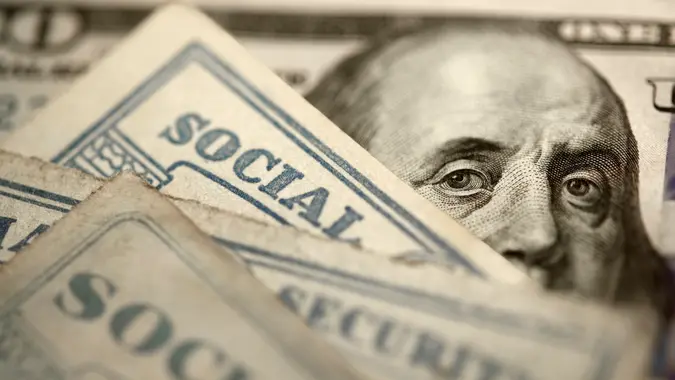Worried About Running Out of Money in Retirement? Here’s the No. 1 Money Move To Make

Commitment to Our Readers
GOBankingRates' editorial team is committed to bringing you unbiased reviews and information. We use data-driven methodologies to evaluate financial products and services - our reviews and ratings are not influenced by advertisers. You can read more about our editorial guidelines and our products and services review methodology.

20 Years
Helping You Live Richer

Reviewed
by Experts

Trusted by
Millions of Readers
Retirement savings are no joke. According to a recent study by Allianz Life Insurance, 63% of Americans worry more about running out of retirement money than dying.
Unfortunately, running out of funds is a real possibility. A new model from investment research firm Morningstar found that approximately 45% of U.S. households won’t have enough to meet retirement expenses.
Some people are more likely to run out than others, and your savings strategy might be the biggest differentiator. Here’s the best money move to make if you don’t want to exhaust your funds early into your retirement.
Also, check out how much savings you need to retire in your state.
Employer-Sponsored Plans Reduce Your Risk
Morningstar’s model showed that defined contribution plans significantly increase your chances of a financially safe retirement. Defined contribution plans are options such as 401(k) and 403(b) plans, to which employees contribute a set percentage of their earnings. Many plans also come with an employer contribution.
Based on Morningstar’s research, the safest scenario is to have at least 20 years of future participation in a defined contribution plan. Just 21% of people in this situation will likely run out of money in retirement.
Morningstar attributes that 21% to people who make poor account management decisions. Opening and contributing to a 401(k) won’t safeguard your retirement if you withdraw early or cash out your account when you switch jobs.
Making the Most of Your Defined Contribution Plan
Those one-in-five odds of having enough money sound good. They sound even better when you consider that 57% of those without a 401(k) or similar plan will run out of funds in retirement. But having an account is just the first smart decision you need to make.
If you want your 401(k) or 403(b) to work as hard as possible for you, you need to treat it like the investment it is. Follow these five best practices:
- Let contributions vest: Many defined contribution plans have a waiting period when part of the employer contribution belongs to the company. If you leave a job before you become 100% vested, you’ll forfeit some of that money.
- Roll it over: When you leave a job, keep your money growing by transferring your defined-contribution account balance to another retirement plan, such as an individual retirement account (IRA) or a 401(k) at another company.
- Avoid 401(k) loans: A 401(k) generates interest that becomes part of the account, thus earning more interest. The process is called compounding, and borrowing against your balance interrupts that process. Also, if you leave your job, you’ll have to pay back what you borrowed out-of-pocket.
- Balance your portfolio: Most 401(k) plans let you choose your investments. Consider all your options and diversify as much as possible. Remember that equities can be riskier but keep pace with inflation more effectively.
- Adjust contributions as necessary: Make it part of your annual financial routine to look at your salary and account contributions and decide whether it makes sense to contribute more. For example, if you receive a cost-of-living raise, choose how much of that should go into your contribution.
It’s OK to get help managing your 401(k). We’re not all financial experts, but everyone deserves a healthy retirement balance. Don’t be afraid to consult with a financial advisor, even if you’re unsure what questions to ask.
If You Don’t Have a 401(k)
If you don’t have access to a 401(k), don’t panic — you’re one of about 57 million Americans in the same situation, according to AARP. Whether you’re self-employed or your work situation doesn’t include benefits, there are retirement savings vehicles that can work for you.
The best-known option is an IRA. Like a 401(k), an IRA grows your retirement savings through strategic investments. A traditional IRA takes pre-tax contributions, similarly to a 401(k), while a Roth IRA lets you contribute money you’ve already paid taxes on. You’ll owe taxes on IRA withdrawals, but many people are in lower tax brackets after they retire.
If you’re self-employed, you have even more options, such as the simplified employee pension (SEP) IRA and the one-participant 401(k).
The main drawback of IRA and IRA-style accounts is the annual contribution limit. If you feel behind on your savings and can contribute more than the limit, consider putting the extra into an investment account or annuity.
When in doubt, consult with an advisor. Investing in guidance now may help you avoid outliving your money later.
More From GOBankingRates
 Written by
Written by  Edited by
Edited by 

























